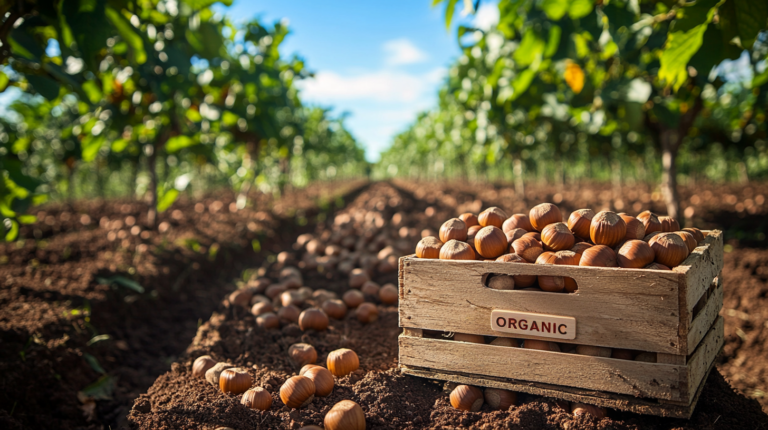Current Trends in the Global Hazelnut Market
The global hazelnut market is experiencing dynamic changes driven by shifting consumer preferences, advancements in cultivation practices, and emerging markets. This article provides a comprehensive overview of the current trends in the global hazelnut market, offering valuable insights for commercial growers, researchers, hobbyist gardeners, and the general public.
1. Overview of the Global Hazelnut Market
Hazelnuts are primarily produced in Turkey, Italy, the United States, Spain, and Azerbaijan. These countries contribute significantly to the global supply, with Turkey alone accounting for approximately 70% of the world’s production. The demand for hazelnuts continues to rise, influenced by their nutritional benefits, versatility in culinary applications, and growing consumer interest in plant-based and health-focused foods.
2. Key Trends Shaping the Market
Several key trends are shaping the global hazelnut market, reflecting changes in production, consumption, and market dynamics.
a. Increasing Demand for Healthy Snacks
Health-conscious consumers are driving the demand for hazelnuts as a nutritious snack. Rich in healthy fats, proteins, vitamins, and minerals, hazelnuts are being incorporated into a variety of health-focused products, including snack bars, nut butters, and dairy alternatives.
- Functional Foods: Hazelnuts are being used in products that promote heart health, weight management, and overall wellness.
- Clean Label: Consumers are seeking products with simple, natural ingredients, and hazelnuts fit well into this trend.
b. Growth of Organic and Sustainable Hazelnuts
Sustainability and organic farming practices are becoming increasingly important to consumers and producers alike. Organic hazelnuts are grown without synthetic pesticides and fertilizers, making them attractive to health-conscious and environmentally aware-consumers.
- Organic Certification: More growers are obtaining organic certification to meet market demand and command premium prices.
- Sustainable Farming Practices: Techniques such as integrated pest management, crop rotation, and reduced chemical use are being adopted to promote sustainability.
c. Technological Advancements in Cultivation
Technological innovations are enhancing hazelnut cultivation, and improving yield, quality, and resistance to pests and diseases.
- Breeding Programs: Research institutions are developing new hazelnut varieties that are disease-resistant, high-yielding, and suited to different climates.
- Precision Agriculture: Technologies such as soil sensors, drones, and GPS mapping are helping farmers optimize irrigation, fertilization, and pest control.
d. Emergence of New Hazelnut-Producing Regions
While traditional hazelnut-growing regions remain dominant, new areas are emerging as significant producers, diversifying the global supply.
- Eastern Europe: Countries like Georgia and Ukraine are increasing their hazelnut production, benefiting from favorable climates and investment in agriculture.
- Asia-Pacific: China and Australia are expanding their hazelnut cultivation, tapping into growing regional demand.
e. Consumer Preferences for Quality and Flavor
Consumers are increasingly discerning about the quality and flavor of hazelnuts. Varieties known for their superior taste, texture, and culinary versatility are in high demand.
- Premium Products: High-quality hazelnuts are used in premium confectionery, chocolates, and gourmet foods.
- Flavor Innovations: Companies are experimenting with new flavors and forms, such as flavored roasted hazelnuts and hazelnut-based spreads.
3. Market Dynamics and Pricing Trends
The global hazelnut market is influenced by various factors, including production volumes, weather conditions, and geopolitical events.
a. Production Volumes and Weather Impact
Hazelnut production is sensitive to climatic conditions, with factors such as temperature, rainfall, and frost impacting yields.
- Weather Variability: Climate change and unpredictable weather patterns can lead to fluctuations in production and supply.
- Harvest Seasons: Understanding the timing and conditions of harvest seasons in major producing countries is crucial for market forecasting.
b. Geopolitical Factors
Geopolitical events and trade policies can affect the hazelnut market, influencing prices and trade flows.
- Trade Agreements: Bilateral and multilateral trade agreements impact tariffs and export opportunities for hazelnut-producing countries.
- Sanctions and Restrictions: Political tensions and sanctions can disrupt supply chains and affect market stability.
c. Pricing Trends
Hazelnut prices are subject to variability based on supply and demand dynamics, production costs, and market speculation.
- Price Fluctuations: Seasonal variations, crop yields, and market demand influence hazelnut prices.
- Premium Pricing: Organic, sustainably grown, and high-quality hazelnuts often command higher prices in the market.
4. Emerging Markets and Consumer Demand
Emerging markets in Asia-Pacific, the Middle East, and Latin America are showing increasing demand for hazelnuts, driven by rising incomes and changing dietary habits.
a. Asia-Pacific Growth
Countries like China, Japan, and South Korea are experiencing growing demand for hazelnuts, fueled by increasing health awareness and Western dietary influences.
- Market Expansion: Efforts to promote hazelnut consumption through marketing and distribution channels are expanding the market.
- Product Development: Innovations in hazelnut-based products tailored to regional tastes are boosting consumption.
b. Middle East and North Africa (MENA)
The MENA region is seeing rising demand for hazelnuts, driven by their use in traditional sweets and new product innovations.
- Traditional Uses: Hazelnuts are integral to many traditional Middle Eastern confections, such as baklava and Turkish delight.
- Modern Applications: New product development, including hazelnut-flavored snacks and dairy alternatives, is gaining popularity.
c. Latin America
Latin American countries are beginning to explore hazelnut cultivation and consumption, supported by favorable climates and growing consumer interest.
- Cultivation Initiatives: Countries like Chile and Argentina are investing in hazelnut farming, leveraging suitable growing conditions.
- Consumer Education: Efforts to educate consumers about the benefits and uses of hazelnuts are helping to drive demand.
5. Challenges and Opportunities in the Hazelnut Market
While the hazelnut market presents significant opportunities, it also faces challenges that must be addressed.
a. Challenges
- Pest and Disease Management: Managing pests and diseases, such as Eastern Filbert Blight and bacterial blight, is crucial for maintaining healthy crops.
- Climate Change: Adapting to changing climate conditions and mitigating their impact on hazelnut production is a key concern.
- Supply Chain Disruptions: Ensuring a stable and efficient supply chain is essential for meeting global demand and maintaining market stability.
b. Opportunities
- Innovation in Products: Developing new and innovative hazelnut-based products can capture consumer interest and expand market reach.
- Sustainability Practices: Embracing sustainable farming practices can enhance environmental benefits and appeal to eco-conscious consumers.
- Market Diversification: Exploring new markets and expanding distribution networks can help growers and producers tap into emerging demand.
6. Future Prospects and Conclusion
The future of the global hazelnut market looks promising, with ongoing research, technological advancements, and market expansion contributing to growth. By addressing challenges and leveraging opportunities, the hazelnut industry can continue to thrive and meet the evolving needs of consumers worldwide.
References
- FAO: Food and Agriculture Organization of the United Nations
- Hazelnut Growers of Oregon: Oregon Hazelnuts
- International Nut and Dried Fruit Council: INC
- Research Articles: Relevant research articles on hazelnut market trends and dynamics.






